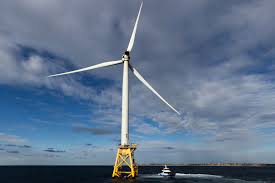New Jersey’s quest to lead the nation in clean, renewable energy has hit some unexpected bumps in the road, particularly in the promising but complex world of offshore wind energy. The state’s ambitious goals of powering its homes and businesses with clean, sustainable energy have faced hurdles that have delayed progress, including a significant setback in the development of a massive offshore wind farm near Atlantic City. In this article, we’ll dive deep into the reasons behind the cancellation of the Atlantic Shores wind farm, explore what it means for New Jersey’s green energy future, and discuss the larger implications for the state’s renewable energy vision.
The Rise of Offshore Wind Energy in New Jersey
Offshore wind energy has long been seen as a cornerstone of New Jersey’s future energy plans. The state has set a target to generate 7,500 MW of offshore wind energy by 2035, a move aimed at reducing dependence on fossil fuels while also creating thousands of new jobs and stimulating local economies. By harnessing the power of winds just off its coastline, New Jersey has the potential to become a leading player in offshore wind energy in the U.S.
One of the most talked-about projects in the state was Atlantic Shores Offshore Wind, a large-scale wind farm planned for construction off the coast of Atlantic City. With the backing of global energy giants, this project was once poised to become a game-changer for both the economy and the environment in New Jersey. However, a combination of economic pressures, political setbacks, and regulatory challenges has recently caused this groundbreaking project to come to a halt.
Why Did Atlantic Shores Wind Farm Get Cancelled?
The cancellation of the Atlantic Shores wind farm marks a significant moment in New Jersey’s renewable energy timeline. After years of planning, negotiations, and public excitement, Atlantic Shores made the decision to withdraw its application for the Offshore Renewable Energy Certificates (OREC) needed to proceed with its Offshore Wind Project 1. This came as a result of several key challenges:
- Economic Pressures: The cost of offshore wind development has increased dramatically in recent years. With inflation, rising interest rates, and supply chain issues, the economic feasibility of the project became more difficult to sustain. As the financial landscape shifted, Atlantic Shores realized that the project could no longer proceed under the original terms.
- Political and Regulatory Setbacks: One of the most significant blows to the Atlantic Shores project came earlier this year when Shell, one of the project’s primary partners, decided to pull out of the venture. This was followed by another major setback in March when the U.S. Environmental Protection Agency (EPA) revoked a crucial air permit that had been granted to the project. The permit’s loss meant that construction couldn’t move forward as planned.
- Federal Moratoriums: The offshore wind sector has faced additional challenges due to federal moratoriums signed by former President Donald Trump, which stalled offshore wind development across the nation. While these moratoriums were meant to protect certain ocean areas from industrial development, they also created uncertainty around the regulatory environment for offshore wind projects.
The Economic and Environmental Promise
Despite the cancellation, Atlantic Shores CEO Joris Veldhoven remained optimistic, stating that the company’s decision to withdraw from the project did not mean an end to its commitment to New Jersey. Veldhoven emphasized the company’s belief in the potential of offshore wind to drive economic growth and reduce carbon emissions in the state. The Atlantic Shores project had originally promised an economic impact of up to $1.8 billion, potentially creating thousands of jobs in the renewable energy sector and supplying clean power to hundreds of thousands of homes in the region.
Offshore wind is considered one of the most effective ways to combat climate change while boosting local economies. New Jersey’s proximity to the Atlantic Ocean provides it with a unique opportunity to tap into an abundant resource of wind power, which could play a crucial role in meeting the state’s clean energy goals. The promise of green jobs, cheaper energy prices, and a cleaner environment has made offshore wind a top priority for policymakers in New Jersey.
What’s Next for Offshore Wind in New Jersey?
The cancellation of the Atlantic Shores wind farm may feel like a setback, but it doesn’t mark the end of offshore wind development in New Jersey. The state’s Board of Public Utilities (BPU) has reaffirmed its commitment to renewable energy and emphasized that offshore wind will continue to play a major role in the state’s clean energy future. The BPU’s announcement follows New Jersey Governor Phil Murphy’s pledge to make the state a leader in green energy, with offshore wind at the forefront of that mission.
Although the Atlantic Shores project has been shelved, other offshore wind initiatives are still in progress. Several companies remain committed to offshore wind development in New Jersey, and new partnerships and investments continue to emerge. The state is also moving forward with additional projects, including the Ocean Wind and Garden State Offshore Energy projects, which are set to provide significant amounts of renewable energy in the coming years.
Furthermore, New Jersey’s push for offshore wind energy has garnered significant support from local communities, environmental groups, and businesses that see the long-term benefits of a green economy. New Jersey’s proximity to major urban centers like New York City also makes it an ideal location for offshore wind farms that can provide clean energy to millions of people.
Challenges Remain, But the Future Is Bright
While the Atlantic Shores wind farm cancellation presents a clear setback for New Jersey’s offshore wind goals, it also highlights the broader challenges faced by the renewable energy sector. From navigating complex permitting processes to addressing rising construction costs, offshore wind is not without its obstacles. However, the state’s commitment to clean energy remains unwavering.
As technology improves, costs decrease, and political support grows, the potential for offshore wind to revolutionize New Jersey’s energy landscape remains strong. Even as setbacks like the cancellation of the Atlantic Shores wind farm make headlines, the future of renewable energy in New Jersey continues to look bright. The state’s ongoing investments in wind, solar, and other green technologies will be crucial as we move toward a more sustainable future.
New Jersey’s Offshore Wind Energy Journey Continues
The cancellation of the Atlantic Shores offshore wind farm marks a difficult chapter in New Jersey’s renewable energy story. However, it is not the end. New Jersey’s vision of becoming a leader in offshore wind energy is still very much alive, with other projects in development and ongoing support from the state government and the public. While challenges remain, New Jersey’s commitment to a cleaner, greener future remains steadfast.
For more updates on New Jersey’s renewable energy projects, including the state’s plans for offshore wind, visit Explore New Jersey’s Cutting Edge Energy Projects.
As the state continues to push forward with its green energy ambitions, we can expect New Jersey to remain a key player in the transition to a sustainable, carbon-free future. The journey is far from over, and the best is yet to come.











